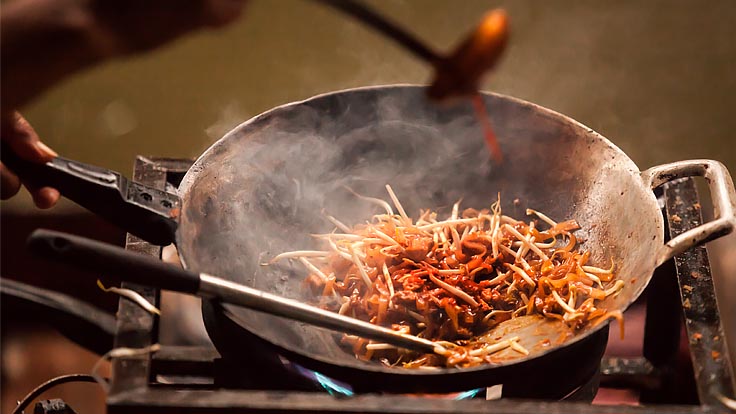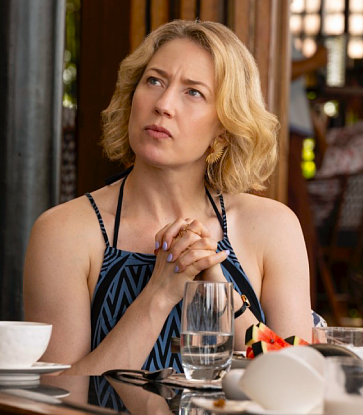“This is not phad thai at all. Phad thai must be sweet, sour, and salty.”
Gordon Ramsay faced this harsh criticism from the head chef of the Blue Elephant in London.
“I think that it doesn’t taste too bad,” Gordon fires back.
“For you, but not for me.”
That’s how Chef Chang shut down the star chef of the TV cooking show The F Word. The video clip of Gordon Ramsay being taken down a notch by Chef Chang has been viewed over 8.1 million times on YouTube.

Pad thai, or more accurately phad thai, the star of Thai cuisine, was born in the 20th century during World War 2. Prime Minister Field Marshal P. Phibunsongkhram started a campaign to save national rice stockpiles, as the country was facing an economic downturn, by encouraging Thais to eat more noodles. Because fried noodle dishes were considered more Chinese than Thai, a dish was developed with a more “Thai” feel and flavour. So, pork and soy sauce were replaced with more Thai ingredients that were affordable and accessible, such as dried shrimp, yellow tofu, lime, bean sprouts, ramsons, and banana flowers.
Phad thai has also been making its mark in popular culture. With the 2004 hit movie “Phad Thai Bride”, featuring Napakpapha “Mamee” Nakprasitte, the hottest local star at that time, phad thai soared to the heights of tom yum gung as Thailand’s national dish. This tasty noodle dish became an ambassador of Thai cuisine, becoming a favourite menu item in Thai restaurants all over the world.
Menus feature the renowned Thai dish as a tempting introduction to the delectable joys of Thai food, especially for those who prefer less spicy heat. But what makes a perfect plate of phad thai?

Two phad thai masters, Chef Andy Yang of Eat Pad Thai (Bib Gourmand, MICHELIN Guide Thailand 2020) and Chef Sujira “Aom” Pongmorn of Baan Phadthai (Bib Gourmand, MICHELIN Guide Thailand 2020), reveal their secrets that you can try at home.
Why is phad thai remarkable to you?
Chef Aom: It’s a perfect blend of Thai and Chinese flavours. You have noodles, tofu, dried shrimp, red onions, peanuts, all the way to the tamarind sauce that gives it all a gorgeous sour and sweet taste. All these different ingredients make one delicious dish.
Chef Andy: Phad thai embodies so many flavours. From the piquant sauce to the pungent, salty fish sauce to the sugar creating a light sweetness -- all these flavour profiles, all in one dish. It’s one of the hardest dishes in the world to master, requiring five of the world’s oldest cooking techniques. Just to make one dish of noodles.
What makes phad thai so delicious?
Chef Aom: The sauce. It’s a blend of three fundamental flavours -- sweet from sugar, sour from tamarind, and spicy heat from seasonings. Then there are the noodles; they have to be tender, tempting you to take a bite. Every ingredient must be fresh, and it’s important to know how to control the heat as you stir fry. Combining all these components for delicious phad thai is a science.
Chef Andy: Truly delicious Thai food is the hardest in the world to make because it relies on fire. You must learn and then practice. Like Kung Fu. To become a master, you must practice. And with practice, different people develop different flavours. Lighting a fire does not mean even heat. This is the enchantment of Thai food, and this is what helps create phad thai with succulent noodles and exquisite flavours.

What makes your phad thai special?
Chef Aom: Our sauce and fresh ingredients. We use almost 18 components to build the flavours in our sauce that everyone loves. The inspiration for my phad thai comes from Thailand’s eastern coastal region, along the gulf, which means seafood. We use blue crab and mud crab, even in the sauce. Then we add home-style accompaniments like pickled radishes, roasted nuts, roasted dried chili peppers, as well as bean sprouts from our garden.
Chef Andy: When I was a kid, I didn’t like to eat phad thai, but I really liked the phad thai at Saphan Phuth. When I set up shop in New York, I wanted to recreate those phad thai flavours that I remembered and loved. So, my phad thai utilises five culinary principles -- infusion, caramelisation, barbeque smoking, al dente textures, and glazing. Infusion comes from meat adding rich flavours and aromas. Caramelisation comes from when the onions, daikon, and tofu practically melt together in the oil, creating a fragrant sweetness. When you add the eggs, they soak up all that tastiness. And the stove’s heat helps build a beautiful bouquet of barbeque smokiness that adds to the overall aroma. You must be good at tossing the pan and controlling the heat so that every strand of noodle is evenly coated. This is why my phad thai requires these five techniques. Then we add our sauce featuring tamarind, sugar, and fish sauce for sour, sweet, and salty. All mixed and blended, the tamarind and sugar melting together, every noodle is perfectly glazed.

What’s the secret to making delicious phad thai?
Chef Aom: Cook from the heart. Try to make your own sauce, and don’t forget to use the freshest ingredients you can find. I use freshly prepared sauce and noodles and the best ingredients and spices. I also make sure to pay attention to the heat as I’m cooking.
Chef Andy: It’s definitely not too hard to do at home. I suggest using a non-stick Teflon pan. Heat the pan before adding the oil, then slowly add the meat, aromatics, and seasonings. Then add eggs and noodles and stir fry for a bit before you add the sauce. Fry and toss in the pan until the sauce is evenly distributed before you remove from the heat.
What should we avoid doing when making phad thai?
Chef Aom: Don’t use high heat. You should practice controlling the temperature because people tend to go too high. That’s when noodles burn before the sauce can coat them evenly. This is probably because people try to imitate street vendors. Learn to control the heat first. You don’t need to start too hot. Just gradually adjust as you cook.
Chef Andy: Watch the heat. Be careful with the hot pan. Meat, aromatics, egg, noodles, then sauce, in that order. If you can make an omelette at home, you got this.









%20-%20Aman%20Nai%20Lert.jpg)
.jpg)









